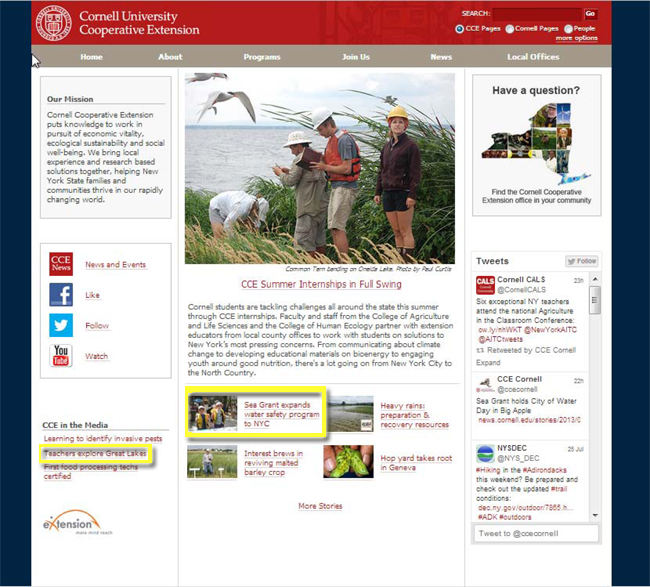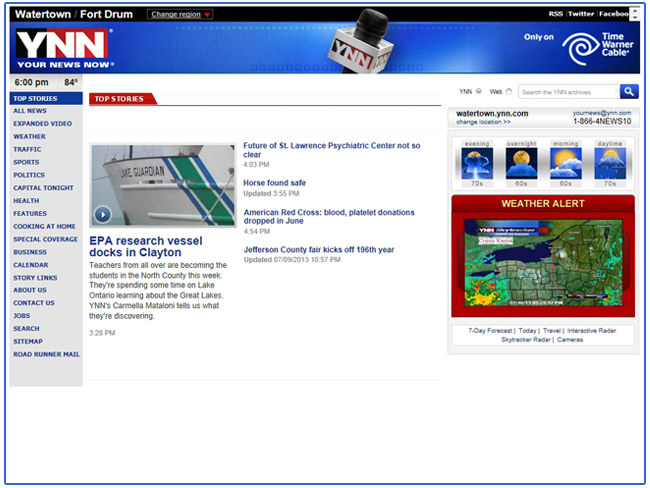Buffalo, NY, December 9, 2013 - YouTube clips, picture-laden blog entries and social media posts are
some of the innovative ways the New York Sea Grant-led "Lake Ontario
Shipboard and Shoreline Science Workshop" garnered attention this past
summer.
During a week in July, some 15 educators from across five Great
Lakes States—Illinois, Minnesota, Pennsylvania, Ohio and, of course, New
York—received a hands-on training from NYSG specialists and funded
researchers on some key freshwater issues, including invasive species,
harmful algal blooms, dunes and wetlands preservation/restoration and
sportfishing. This marked the first time in five years that the U.S.
Environmental Protection Agency's 180-foot R/V Peter L. Wise Lake Guardian has been out on Lake Ontario for this week-long event and it'll be another five before it comes around again.
On YouTube: Teachers Participate in Research on Great Lakes (August 2013)
After Your News Now reporter Carmella Mataloni first shadowed the
educators for a day in early July 2013 while aboard the U.S. EPA'sR/V Lake Guardian, YNN's Terry Ettinger filed a follow up story in August, which is featured above. The transcript for this video, as well as blog posts and additional content related to the week-long workshop, is featured below ...
When these 15 teachers return to the classroom in the fall, they’ll be well briefed on the environmental problems percolating in the Great Lakes, especially Lake Ontario.
"Oh there are a lot of problems. My specialty happens to be algal blooms in drinking water, so we’ve been looking at water quality as we’ve traveled along and testing samples for blooming algae. We’ve been doing a lot of work on nutrients since nutrients are important in driving the algae that live in the lake. We’ve also been looking at zooplankton because that’s what feeds the fish," said Dr. Gregory Boyer, chair of the State University of New York College of Environmental Science and Forestry's (SUNY ESF) Department of Chemistry and director of Great Lakes Research Consortium.
"Unless students know about their environment, they’re not going to be concerned. If people don’t understand why the (Great) Lakes are important, then they just won’t care. So the nice thing is the teachers are so excited about this that it’s definitely going to translate to their students," said Helen Domske, New York Sea Grant Coastal Education Specialist.
"One of the things that we try to do is make education relevant so students can see how the work that they do all day long corresponds to real-life applications and especially in science and math fields where we don’t have a lot of students choosing that path," said Italo Baldasarre, a teacher at Hyde Park Elementary School in
Niagara Falls, NY and one of the 15 teachers on this week-long cruise on
Lake Ontario aboard the U.S. Environmental Protection Agency's R/V Lake Guardian. "So to bring that experience back to the classroom and have them see just how exciting science can be will benefit those students and have more people select that as a career."
Plus the teachers have the satisfaction of really helping with the research on the health of Lake Ontario with the data to be used by the United States and Canada.

In addition to making a splash on the Cornell University Cooperative Extension homepage during the week-long Lake Ontario "Shipboard and Shoreline Science Workshop," the event also garnered attention from a number of media outlets. There were several stories filed by Your News Now as well as articles by reporters who visited with the educators and researchers on-board to see how their studies were coming along—The Watertown Daily Times, a daily, Thousand Islands Sun, a weekly, and the Oswego-based WRVO / North Country Public Radio.

A considerable amount of media coverage was also do in part by an Associated Press article that ran a day prior to docking in Clayton, which was one of several ports the R/V Guardian stopped at along the route of the entire perimeter of Lake Ontario. The article was quickly picked up by dozens of local papers and online sources, including the Buffalo News, New York's NBC 4, Newsday and News 12 Brooklyn.
On NYSG's Blog: Lake Ontario Shipboard and Shoreline Science Workshop 2013
Entries written by NYSG Web Content Manager Paul C. Focazio, who shadowed the instructors, researchers and educators aboard the Environmental Protection Agency's 180-foot R/V Peter L. Wise Lake Guardian during the week-long training.
Posts feature publications produced by NYSG's extension specialists as well
as some of the program's funded researchers, including Greg Boyer (who was on-board the
whole week, overseeing the data collection from water and Lake Ontario
bottom mud sampling), John Farrell and Michael Twiss, the latter of whom
was also in the lead articlefor the Summer
e-issue of NY Coastlines (click here).
-
July 8, 2013: And We're Off! (click here)
Over a dozen Great Lakes educators begin a full loop around Lake Ontario, and learn along the way. Content is featured from 2011's Lake Ontario: Maps, Facts and Figures, a 28-page, full-color booklet produced in partnership with the Finger Lakes-Lake Ontario Watershed Protection Alliance.
- July 9, 2013: Safety First - But, Are They Harmful? (click here)
After learning about the geology of Yougstown's, where the R/V Peter L. Wise Lake Guardian set off from and onto Lake Ontario, the teachers got schooled in Lake Ontario's algal issues from NYSG-funded investigator Dr. Greg Boyer. Of all of the factors Boyer identified that cause algal blooms, State University of New York College of Environmental Science and Forestry researcher pointed to one that humans can control.
- July 10, 2013: Let the Sampling Begin! (click here)
Educators draw water and soil samples and make observations on Lake Ontario's chemistry and critters at some 16 stops in a marathon two-day expedition.
- July 12, 2013: Lights, Camera ... Clayton! (click here)
Even in this quaint village on the St. Lawrence River, the educators learn it's not easy to go unnoticed by the locals, tourists, and the media; Laboratory work takes center stage as the teachers reveal to reporters what's in the water samples they've been drawing from Lake Ontario.
On YouTube: EPA research vessel docks in Clayton, NY (July 2013)
- July 24, 2013: Great Lakes Studies A-Go on Governor's Island (click here)
Lake and River learning from SUNY ESF researchers studying the ecosystem via a remote island, one of few inhabited in the region's 1,800+ chain.
- August 6, 2013: Of Sands and Salmon (click here)
On dry land again, the educators talk with media and legislators on what they'll bring back to the classroom and what they've learned about eastern Lake Ontario's Dunes and Wetlands as well as some of the Lake's key sport-fishing species
More Info:
New York Sea Grant (NYSG), a cooperative program of Cornell University
and the State University of New York, is one of 33 university-based
programs under the National Sea Grant College Program (NSGCP) of the
National Oceanic and Atmospheric Administration (NOAA). The NSGCP
engages this network of the nation’s top universities in conducting
scientific research, education, training and extension projects designed
to foster science-based decisions about the use and conservation of our
aquatic resources. Through its statewide network of integrated
services, NYSG has been promoting coastal vitality, environmental
sustainability, and citizen awareness about the State’s marine and Great
Lakes resources since 1971.
For updates on Sea Grant activities: www.nyseagrant.org has RSS, Facebook, Twitter, and YouTube links. NYSG also offers a free e-list sign up via www.nyseagrant.org/coastlines for NY Coastlines, its flagship publication, and Currents, its e-newsletter supplement, each distributed several times a year.
YNN is one of thirteen 24-hour local news channels owned and operated by
Time Warner Cable nationwide. Content is generated from seven regional
newsrooms. The system has nearly 600,000 subscribers across a 25-county,
15,000 square mile area. YNN Syracuse telecasts one program feed to
Central/Northern NY, one to the Southern Tier. Learn more: www.ynn.com.